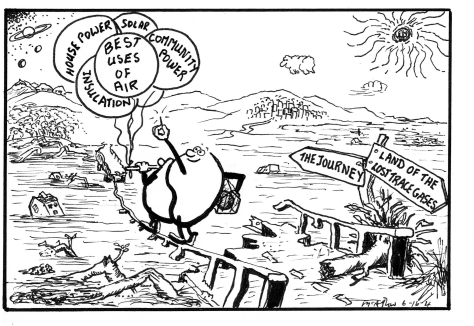
Blue skies appear. The storm fades as quickly as it arrives. Smashed trees, blocked roads and flooded farmlands form a reminder of the event*. We are spared to breathe another day. I journey on in search of the Knowledge Economy with a fresh awareness of Humanity’s need to know, enjoy and work with our climate. We live a trace existence. How can we reduce the risk that we become less than a trace?

JOURNEY
index Look back to
3 Next:
Chapter Seven -A Home at One
The event described happened in February 2004 with rain dumps breaking
records in several areas of New Zealand. Hundreds of houses and thousands
of hectares of farmland were severely damaged with costs in the hundreds of
millions of dollars. A large pine tree on the land of the creator of this
cartoon was damaged when the top from a neigbour’s pine was torn off and
smashed the back of the tree. Six houses beneath the pine are now in danger .
Faced with quotes of many thousands of dollars to have it removed, this cartoon
is being delayed while its creator does the task himself.
Fortunately the Northern
Hemisphere was spared the cataclysmic event portrayed earlier. It is a
hypothetical scenario drawn from a
book this cartoon’s creator was reading as the storm rocked his home in real
life:
The coming Global Superstorm –Art bell and Whitley Strieber. Simon and Schuster.
While the book makes it clear that there is no evidence a superstorm has
occurred it is a reminder of how human civilisations wax and wane with the
weather.
They
base the scenario of how a superstorm might be generated on the following ideas:
“The sequence of events is this: There has to be greenhouse warming and it has
to reach such an extreme that the Arctic itself begins to melt. The Arctic Ocean
has to be flooded with enough freshwater from this melt to cause it to get warm
enough so that the temperature differential with the tropical waters equalizes
sufficiently for the current to weaken.
When the current ceases to penetrate into Artic waters, their temperature will drop. This will cause the tropical airflow to stop and will result in cold air, which had been held in the high Arctic, to plunge southward, colliding with the warm air mass that has moved north. The situation will be exacerbated by the extreme cold of the stratosphere, which will greatly intensify the violence of the storms that result.”
The authors point out that since the 1940s the Antarctic's average annual temperature has increased 6°F and the Artic 8°F. The increased melting is resulting in a reduction of salinity at the extremes of the all important global ocean currents and this is critical in Arctic and Antarctic waters. Ocean currents are weakening.
They also point out that the other most important thing that preserves our present climate, besides the continued stability of the North Atlantic Current, is the relative temperature of the upper atmosphere. These temperatures are dropping rapidly right now because the changed distribution of the Warmer Trace Gases is retaining more thermal energy close to the ground. The greater the difference between the upper and lower atmosphere temperatures, the more potential there is for major weather "events".
The fantasy-adventure film The Day after Tomorrow is based on ideas from the book.
Chapter Six - Land of the Lost Trace Gases - A Trace Too Much causes a Superstorm.
Bonus Joules and the Knowledge Economy: All images on this site are copyright.